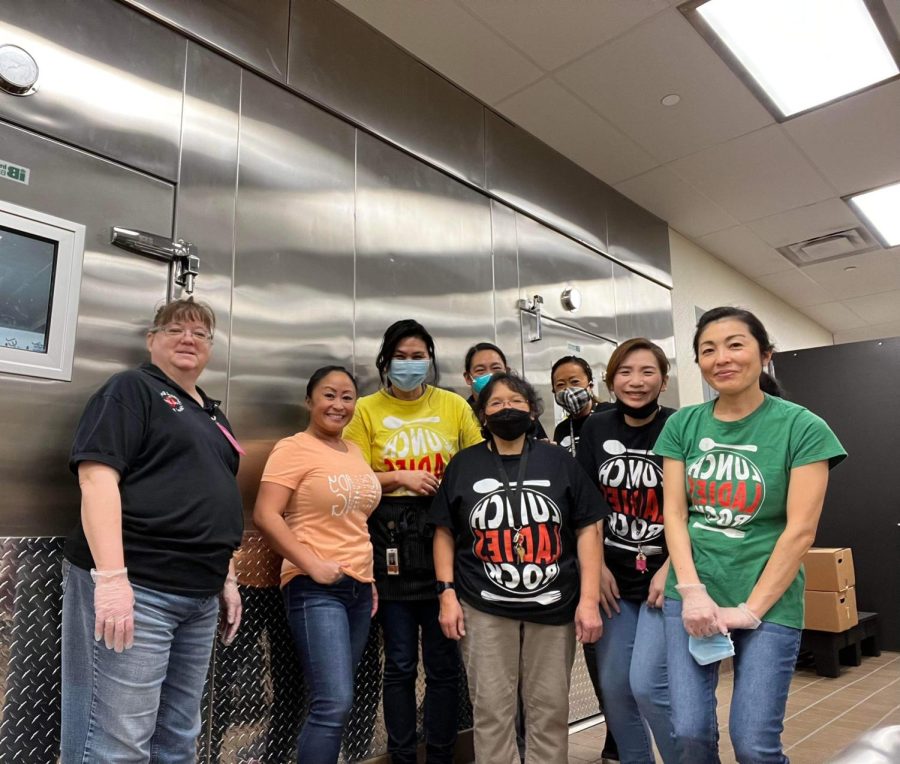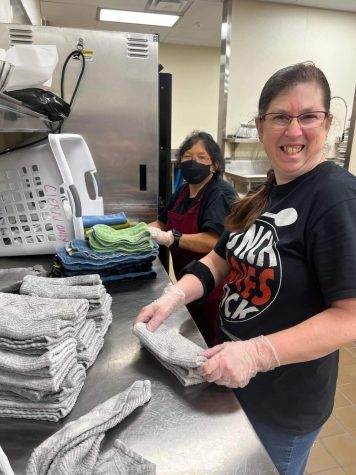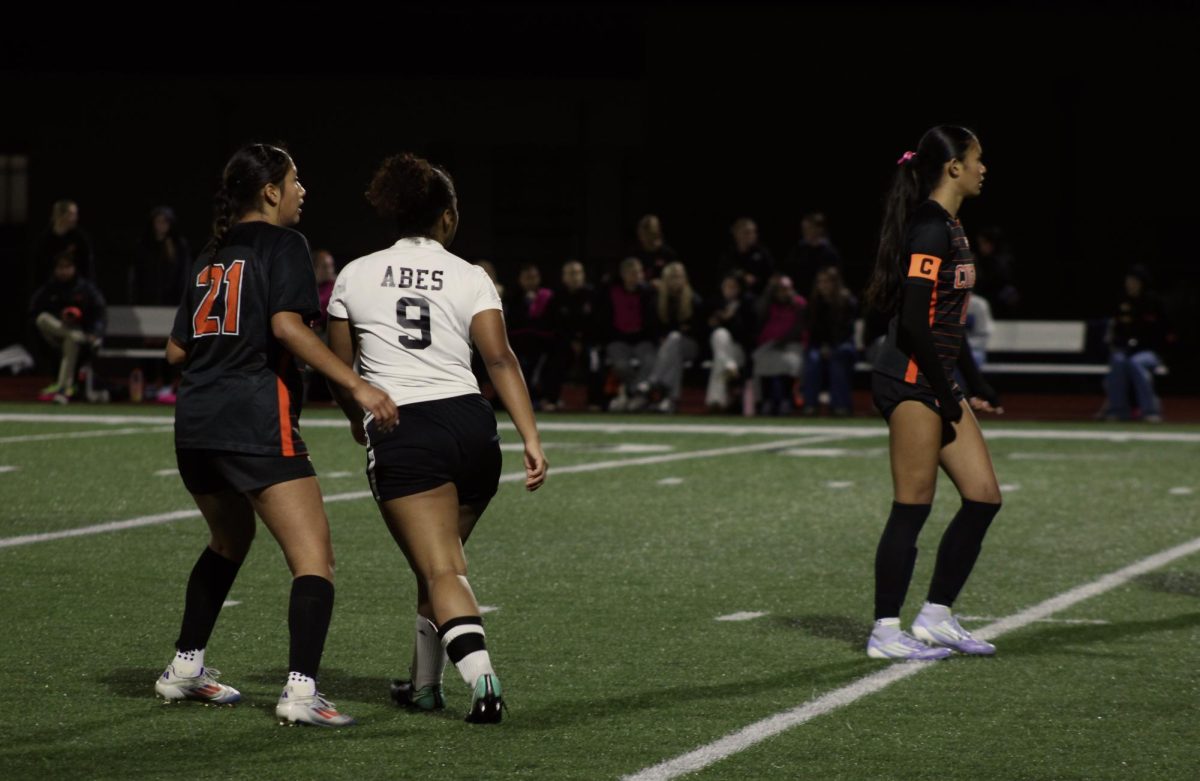The Ins and Outs of School Lunch
How regulations shape the lunches we eat.
The Central Kitsap High School lunch staff group photo. From left to right; Yukari, Yuko, Eva, Lisa, Rie and Sally. Make sure to say “hi” and “thank you” when you see them. Picture provided by Sally Dick.
Every day, about 53.1 million students watch the clock tick down until lunch. Students at Central Kitsap High School are no exception, as they excitedly walk to the common area to be greeted by the wall of windows leading to the perfect view of the Puget Sound. Students rush to get in the lunch line, so they can get their food and the best table with their friends.
As students make their way through the brightly lit alcove of the commons they are greeted by the smiling face of the lunch ladies who work there, while a mix of new and trendy music and everyone’s old favorites plays overhead.
Everyday there is a new main entree, and the entrees that stay throughout the week, which is normally pizza (cheese, pepperoni, or vegetable), cheese burgers or hamburgers (whichever they prepped/ have in stock that day), and chicken burgers (normal or spicy). For sides they have a mix of fruit (apples, oranges, pears), sometimes they have little premade cups of canned fruit, side salads and carrots with ranch, and fries or tater tots that normally get served with the entrees.
As simple as this sounds, there is actually a lot more that goes into how the food arrives from point A to point B.
The food changes first began in 2010 due to Michelle Obama’s Child Nutrition Reauthorization Healthy, Hunger-Free Kids Act of 2010. This is what allowed the government to make regulations regarding school lunches while also allowing them to control federal funding. If they do not follow the set regulations then they are unable to earn federal funding.
This was just the beginning since school lunch regulations changed once COVID-19 hit and the fact that the presidents had changed.
The Trump Agriculture Department attempted to change school lunches but was unable to by the Judge, as he wrote “With the pandemic, and schools being closed, it’s just ridiculous to think that we would want to weaken the standards, and make meals less healthy, when kids go back to school in the fall.” They had tried to make meals sweeter, saltier, and less nutritious while attempting to remain aloof about it.
While there are many differing opinions on school lunches, Central Kitsap High School’s kitchen works like most other kitchens in the food service industry. Their day starts at 5:30 in the morning, beginning with prepping food for the day, which includes; filling sanitizing buckets, cutting and washing fruits and veggies, filling containers with ranch, setting up the buns for hamburgers, cheeseburgers, chicken burgers. They also have to make sure to get all of the food for breakfast ready, which is an array of cereals, fruit, a rotating entree (bagels, donuts, cinnamon rolls, yogurt with granola), regular white and chocolate milk.
At 8:30 a group of the lunch ladies take a break from cooking for about 30 minutes. While some of them are taking a break the others stay in the kitchens to start making the fries or tater tots to go with the hamburgers and chicken burgers. This takes place while the “bigger” portions of the entrees are cooking; the patties, pizza, chicken (for orange or teriyaki), rice that accompanies the orange or teriyaki chicken, or anything other entrees that might be served. After the first group goes on break they come back and start packing the bags or plates that the food comes in.
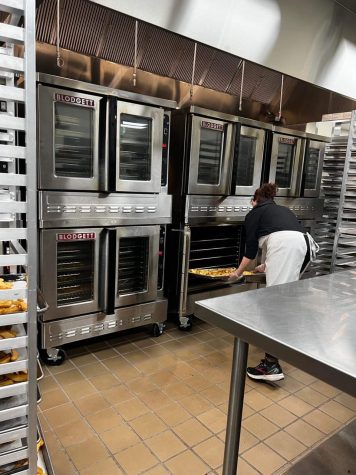
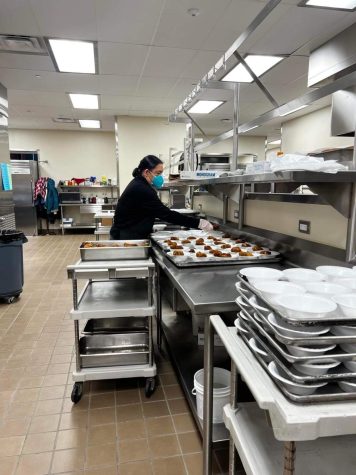
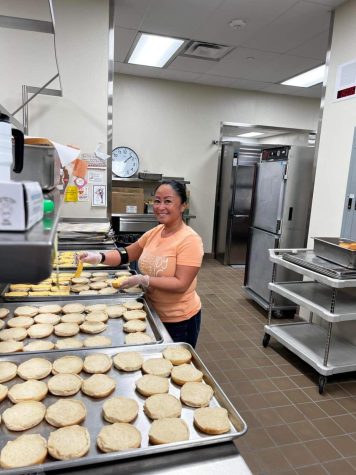
Central Kitsap High School shares a kitchen with Central Kitsap Middle School, which means that everyone who works for the high school is also making food for the middle school, so all of their food numbers are combined. They serve about 250 to 300 breakfast’s and about 1200 lunches between the middle and high school everyday. These numbers fluctuate throughout the week depending on what’s being served. Friday is donut day and at just the high school there were 294 donuts given out (this doesn’t include any of the breakfast options given).
After all of the lunches have ended ,12:45 pm on a regular day and 11:40 on early release days, they mop and close up the front of the kitchen (where students come through). Then, they go through and clean the kitchen; washing dishes, doing and folding laundry, and anything else that needs to be done before the end of the day. The lunch staff then goes home around 2-2:30 and starts again the next day.
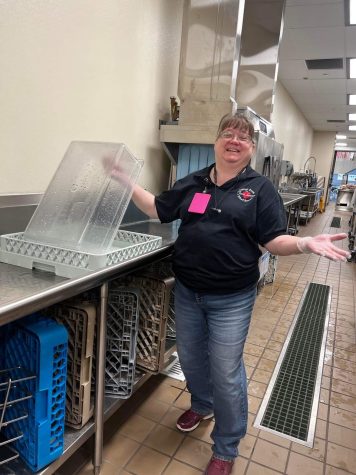
The students and lunch ladies both had varied opinions about school lunch. However, when asked, the students did know that the lunch ladies had school lunch regulations set in place.
“I don’t really eat the food very much, but from what I’ve had, it’s good,” said Sally Dick, one of the multiple lunch ladies who prep and serve school lunches.
Students also shared their own and individual opinions on what they thought of school lunch, each different in some degree.
“I think it could be better but most of the time it’s okay.” said Logan Archer, a 9th grader who’s favorite school lunch is the tuna sandwich.
“I think it could be a whole lot better. It’s okay every once in a while.” said Miki Waggoner, another 9th grader who thinks the best school lunch is the orange chicken and rice. Though, they did make it a point that the two are separate, the chicken tasting better than the rice.
“They could definitely be better,” said Curtis Witcher, an 11th grader who’s favorite school lunch is the cheese sticks. “I feel like there’s a lot of things overcooked.”
He was especially adamant about his thoughts on the school french fries.
“You could use the school french fries as throwing darts, and they would pierce the bowl and the target,” said Witcher. “Not so tough french fries that could kill a man.”
“Just improve the variety of food,” said Andrew Hannifin, another 9th grader who enjoys the regular chicken sandwiches.
When looking over everyone’s own thoughts about school lunches, each opinion definitely differs but could also be related to each other in some way. School lunches have surely changed since before COVID, regarding regulations and foods, but just how much will they end up changing by next year?
The U.S Department Of Agriculture (USDA) in 2020 still kept its restrictions on lunches but made them free to all students and allowed parents to come pick them up within the COVID-19 guidelines set by the schools/states. This trend continued into the 2021-2022 school year, while restrictions were still the same the USDA was much more lenient and had a variety of waivers that mainly pertained to supply chain issues. For the 2022-2023 school year the Biden administration has rolled out a plan that is meant to transition schools back to normal regulations and get them ready for the expansion of regulations for the 2023-2024 school year.
During the 2022-2023 school year cafeterias will be charging for meals again unless you qualify for free or reduced lunch (to find out if you qualify for CKHS free and reduced lunch program go here).
They are also able to now serve low fat chocolate and regular milk instead of only nonfat milk. Also at least 80% of cereal, bread, pasta, or any other food must be whole grain (instead of all foods). Then during the 2023-2024 school year, kitchens will have to watch the amount of salt being put into foods because there will be a 10% decrease of sodium that is allowed in served foods.
In an attempt to add variety to the school lunches, the idea of having a suggestion box has been brought up, a box that’ll allow students to share their opinions and suggestions on what they may like, dislike, or want to see change.
Unfortunately, suggestions for food changes might not be feasible due to the tough spot that the lunch ladies are in when facing school lunch regulations with their limited choices of food they’re able to serve and what they’re able to do with the food itself, but it would help create a connection between the individual groups that consist of students and lunch ladies.

